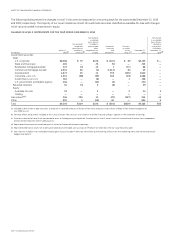GE 2010 Annual Report Download - page 103
Download and view the complete annual report
Please find page 103 of the 2010 GE annual report below. You can navigate through the pages in the report by either clicking on the pages listed below, or by using the keyword search tool below to find specific information within the annual report.
GE 2010 ANNUAL REPORT 101
Phase 2 to assess the potential scope and duration of Phase 2,
as well as operational and engineering changes that could be
required. Based on this review and our best professional engineer-
ing judgment, we increased our reserve for the probable and
estimable costs for completing the Hudson River dredging project
by $845 million in the fourth quarter of 2010.
Uncertainties about the status of laws, regulations, technology
and information related to individual sites make it difficult to develop
a meaningful estimate of the reasonably possible aggregate
environmental remediation exposure; these costs could differ
from our current estimates. Total reserves related to environmen-
tal remediation, including asbestos claims, were $3,510 million
at December 31, 2010.
Note 14.
Income Taxes
PROVISION FOR INCOME TAXES
(In millions) 2010 2009 2008
GE
Current tax expense $ 2,401 $ 3,199 $ 3,844
Deferred tax expense (benefit)
from temporary differences (377) (460) (417)
2,024 2,739 3,427
GECS
Current tax expense (benefit) (2,397) (1,554) (1,460)
Deferred tax expense (benefit)
from temporary differences 1,423 (2,333) (865)
(974) (3,887) (2,325)
CONSOLIDATED
Current tax expense 4 1,645 2,384
Deferred tax expense (benefit)
from temporary differences 1,046 (2,793) (1,282)
Total $ 1,050 $(1,148) $ 1,102
GE and GECS file a consolidated U.S. federal income tax return.
This enables GE to use GECS tax deductions and credits to reduce
the tax that otherwise would have been payable by GE. The GECS
effective tax rate for each period reflects the benefit of these tax
reductions in the consolidated return. GE makes cash payments
to GECS for these tax reductions at the time GE’s tax payments
are due. The effect of GECS on the amount of the consolidated tax
liability from the formation of the NBCU joint venture will be
settled in cash when it otherwise would have reduced the liability
of the group absent the tax on formation.
Consolidated U.S. earnings (loss) from continuing operations
before income taxes were $5,078 million in 2010, $(212) million
in 2009 and $2,956 million in 2008. The corresponding amounts
for non-U.S.-based operations were $9,130 million in 2010,
$10,207 million in 2009 and $16,814 million in 2008.
Consolidated current tax expense includes amounts appli-
cable to U.S. federal income taxes of a benefit of $3,253 million,
$833 million and $651 million in 2010, 2009 and 2008, respec-
tively, related to the benefit from GECS deductions and credits in
excess of GE’s current U.S. tax expense. Consolidated current tax
expense amounts applicable to non-U.S. jurisdictions were
$3,258 million, $2,385 million and $3,027 million in 2010, 2009 and
2008, respectively. Consolidated deferred taxes related to U.S.
Postretirement Benefit Plans
2010 COST OF POSTRETIREMENT BENEFIT PLANS AND CHANGES IN
OTHER COMPREHENSIVE INCOME
Total Principal Other Retiree
postretirement pension pension benefit
(In millions) benefit plans plans plans plans
Cost of postretirement
benefit plans $ 2,979 $ 1,072 $ 474 $1,433
Changes in other
comprehensive income
Net actuarial loss (gain)—
current year 652 1,863 (246) (965)
Prior service cost (credit)—
current year 23 — 23 —
Prior service cost
amortization (883) (238) (14) (631)
Net actuarial gain (loss)
amortization (1,524) (1,336) (210) 22
Total changes in other
comprehensive income (1,732) 289 (447) (1,574)
Cost of postretirement benefit
plans and changes in other
comprehensive income $ 1,247 $ 1,361 $ 27 $ (141)
Note 13.
All Other Liabilities
This caption includes liabilities for various items including non-
current compensation and benefits, deferred income, interest on
tax liabilities, unrecognized tax benefits, environmental remedia-
tion, asset retirement obligations, derivative instruments, product
warranties and a variety of sundry items.
Accruals for non-current compensation and benefits
amounted to $25,356 million and $24,921 million at December 31,
2010 and 2009, respectively. These amounts include postretire-
ment benefits, pension accruals, and other compensation and
benefit accruals such as deferred incentive compensation.
We are involved in numerous remediation actions to clean up
hazardous wastes as required by federal and state laws. Liabilities
for remediation costs exclude possible insurance recoveries and,
when dates and amounts of such costs are not known, are not dis-
counted. When there appears to be a range of possible costs with
equal likelihood, liabilities are based on the low end of such range.
In 2006, we entered into a consent decree with the Environ-
mental Protection Agency (EPA) to dredge PCB-containing sedi ment
from the upper Hudson River. The consent decree provided that
the dredging would be performed in two phases. Phase 1 was
completed in May through November of 2009. Between Phase 1
and Phase 2 there was an intervening peer review by an indepen-
dent panel of national experts. The panel evaluated the perfor-
mance of Phase 1 dredging operations with respect to Phase 1
Engineering Performance Standards and recommended proposed
changes to the standards. On December 17, 2010, EPA issued its
decisions setting forth the final performance standards for Phase 2
of the dredging project, incorporating aspects of the recommen-
dations from the independent peer review panel and from GE. In
December 2010, we agreed with EPA to perform Phase 2 of the
project in accordance with the final performance standards set by
EPA. We have reviewed EPA’s final performance standards for
























